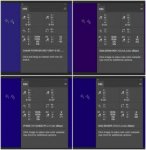printshoppe
New member
I recently had an issue with an online printer doing a dye sub table cover for me. I made the color C100+M100 expecting to get a dark purple, as is shown in the Pantone CMYK formula guide. When I received it, it was a cobalt blue color. Here is the response I received from the company:
I called them to discuss and they 100% said I was wrong, and that this CMYK formula will print blue. I first politely asked them what reference book they were using to draw this conclusion. They told me they do not have any CMYK swatch books in their facility since they do not "color match or print Pantone colors", but that they do 5000 jobs per day, and nobody else has complained about the color of their prints. I tried to explain to them that a CMYK reference swatchbook has nothing to do with "Pantone" colors which I think they were confusing with spot colors. I became increasingly agitated by the prepress manager's lack of knowledge and insistence that C100 M100 prints blue. In all my 35 years in the industry, it is a known fact that this color may appear blue on the monitor, but when printed it comes out purple. Most of the time, my clients complain when their CMYK blue builds come out to purple. I tell them the rule of thumb that your magenta should be 30% less than the cyan to avoid a purple shift.
Either everything I have learned in the past 35 years is completely wrong and all my CMYK swatchbooks are incorrect, or this company is clueless and needs to get a basic education. THOUGHTS???
| One of our representatives has responded to your claim for job A613220-01/(171792) please see below. |
| Hello, After reviewing your claim ticket we will be unable to reprint this order. 100% Cyan and magenta is the composite for a blue print. We sincerely apologize for the inconvenience but since we do not offer color matching and the values are not correct for a purple print. Thank You |
I called them to discuss and they 100% said I was wrong, and that this CMYK formula will print blue. I first politely asked them what reference book they were using to draw this conclusion. They told me they do not have any CMYK swatch books in their facility since they do not "color match or print Pantone colors", but that they do 5000 jobs per day, and nobody else has complained about the color of their prints. I tried to explain to them that a CMYK reference swatchbook has nothing to do with "Pantone" colors which I think they were confusing with spot colors. I became increasingly agitated by the prepress manager's lack of knowledge and insistence that C100 M100 prints blue. In all my 35 years in the industry, it is a known fact that this color may appear blue on the monitor, but when printed it comes out purple. Most of the time, my clients complain when their CMYK blue builds come out to purple. I tell them the rule of thumb that your magenta should be 30% less than the cyan to avoid a purple shift.
Either everything I have learned in the past 35 years is completely wrong and all my CMYK swatchbooks are incorrect, or this company is clueless and needs to get a basic education. THOUGHTS???













